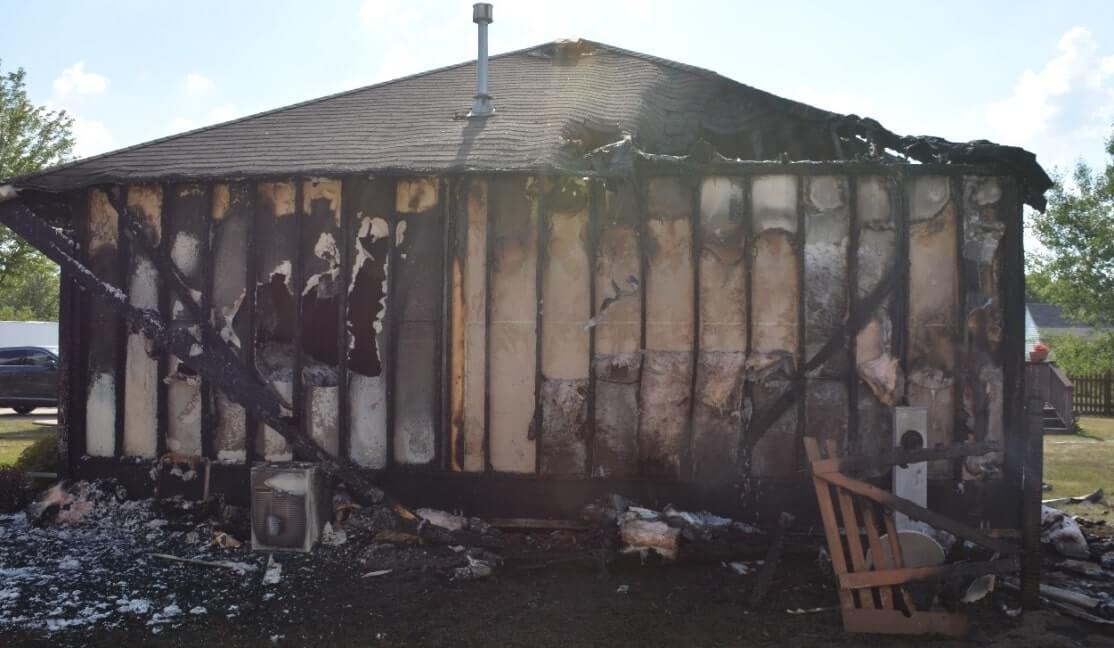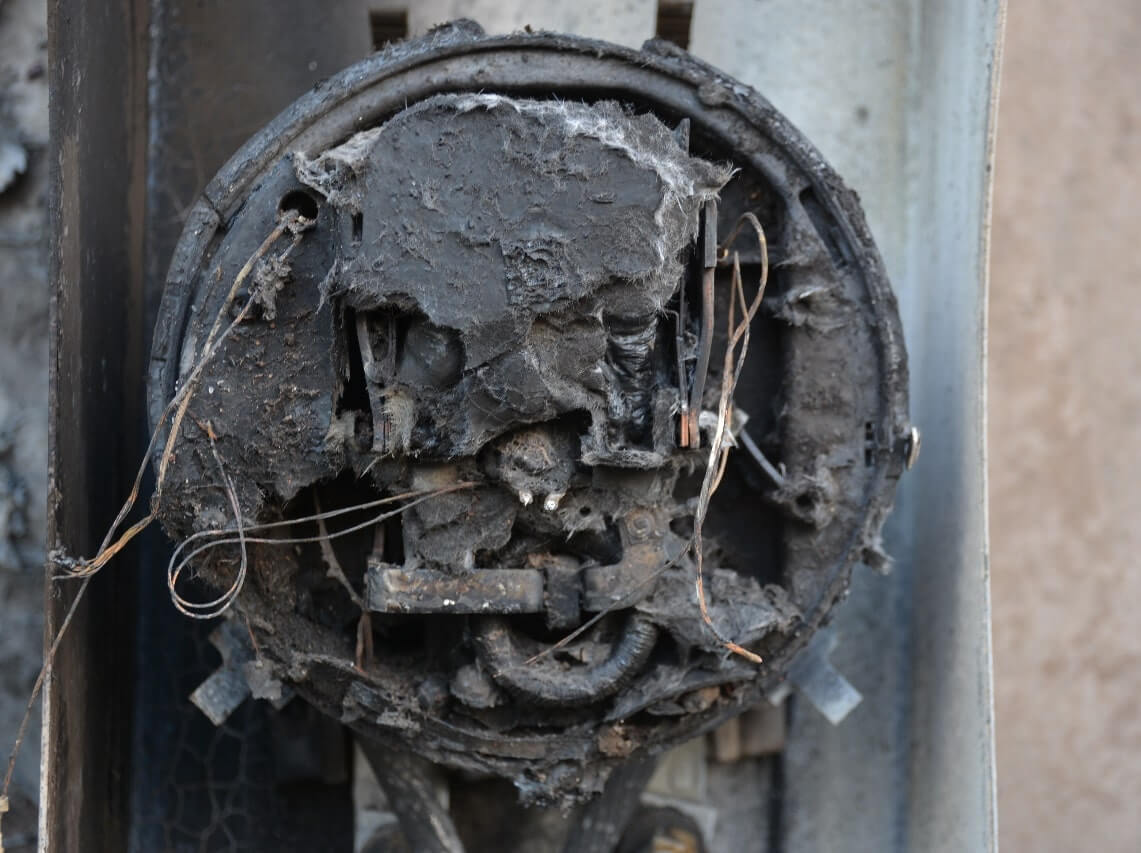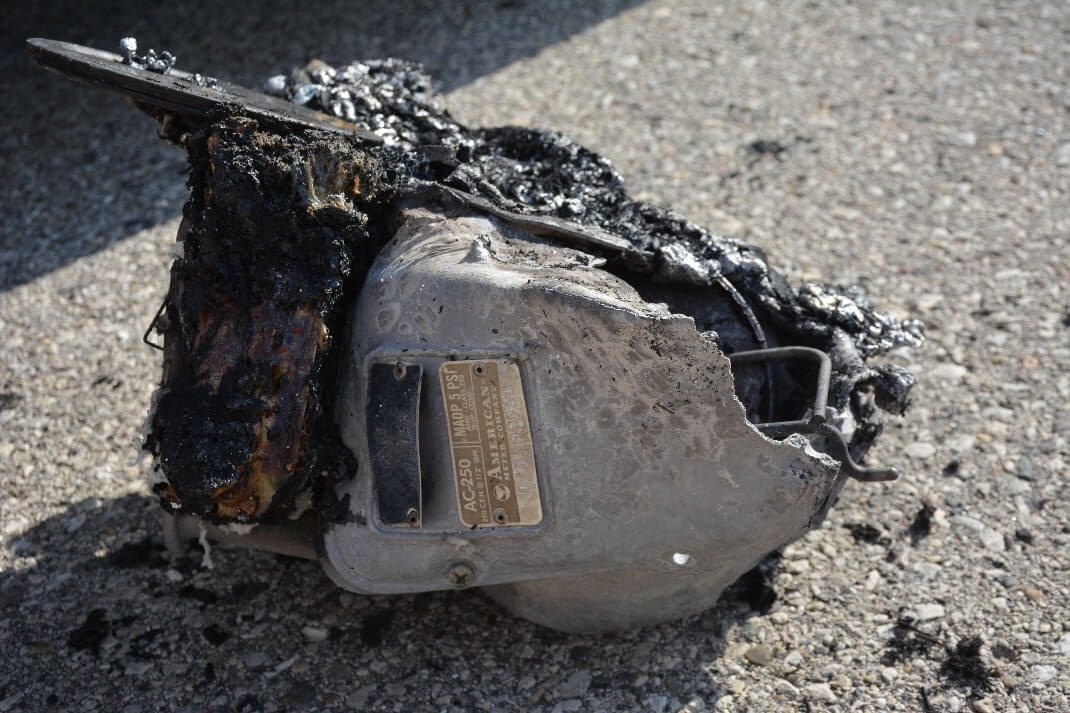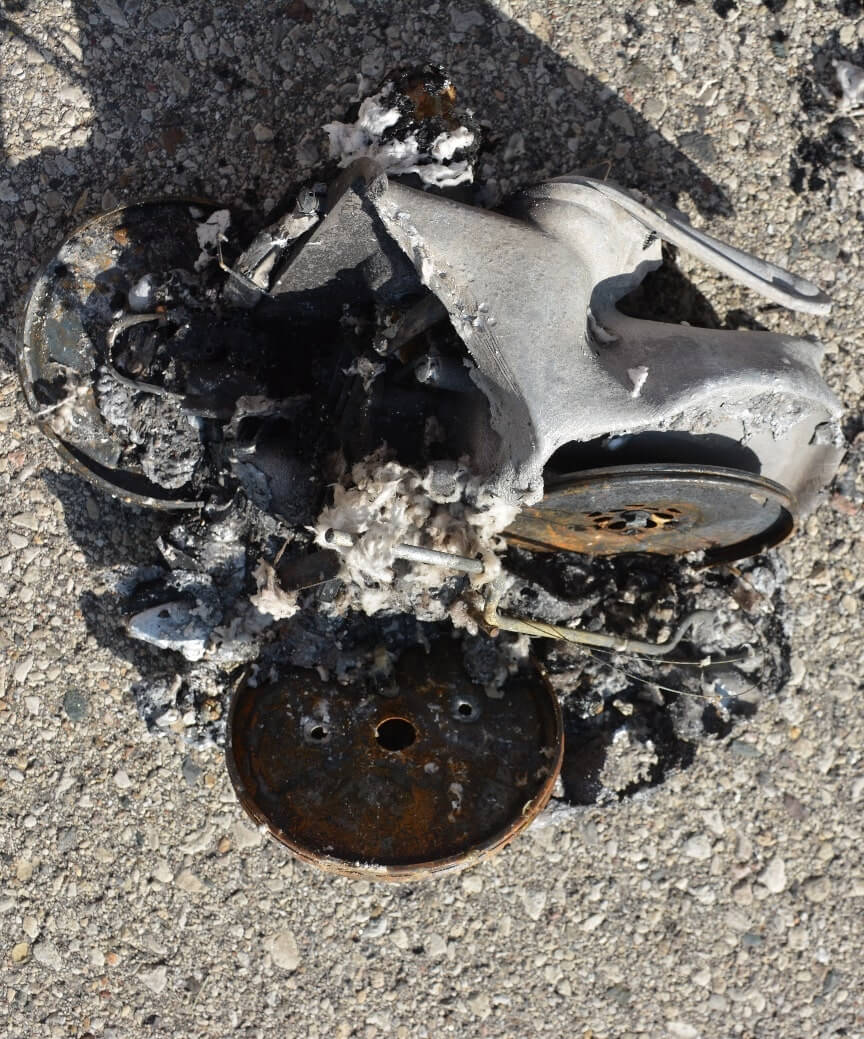10 min read | 2984 words | 544 views | 0 comments

On July 6th, 2020, at approximately 3:05pm, the Waukesha Fire Department responded to a local house fire. Of course, that's what their firefighters are paid to do everyday. What was odd about this fire were some of the details regarding how the fire started and the nature of the response to it. Suspicions were further intensified as the investigation began to unfold, and the puzzle pieces began pointing to a familiar culprit: smart meters.
→ Press release from Wireless Action ←
Smart meters, of course, are the digital, usually wireless, utility meters that have gained popularity among utilities throughout the past two decades. They allow utilities to remotely monitor and control electricity usage, which has allowed them to fire their meter readers and sell data about your electricity usage to government and third-party agencies (if this sounds eerily like 1984, well, it is). Utilities don't really care that smart meters are carcinogenic, cause numerous health issues, overcharge, waste energy, are insecure, are designed to fail, are prone to fires and explosions, and violate customers' Fourth Amendment rights. They've been bullying customers coercively into having these devices on their homes for years, even when there is no legal basis for the forcing of these smart stupid meters on people's homes and businesses.
Of course, most people don't know what smart meters are, and even fewer people care about their effects, which is why picking out when smart meters have been causing havoc isn't always obvious. Nonetheless, numerous people, including electricians and industry whistleblowers, have testified before regulatory and legislative bodies about the dangers and stupidities of so-called "smart" meters many times, and many fire departments around the country have begun wising up to their dangers.
Josh Hart, Stop Smart Meters: And so the fire department basically said that the meters started the blaze?
Witness: He took one look at the wreckage and said, "smart meters," and walked away, and never called back or came back.
Josh Hart, Stop Smart Meters: Brittany, you were saying earlier there were no smart meter fires and this lady right here has pictures of her smart meter that exploded on her house.
Utility Rep: Josh, can I ask you to stop recording?
Wireless Action began its own informal investigation into the incident. After consultation with other smart meter experts, submitting multiple public records requests, analyzing evidence from the fire scene, and reaching out to both the local fire marshal and WE Energies, Wireless Action came to the conclusion that the "smart" electric meter almost certainly played some role in the inferno which caused $100,000 in damages and dislocated the occupants of the house for an expected six months while rebuilding occurs. Fortunately, unlike many homes and lives which have been outright destroyed or killed by "smart" meter induced infernos, nobody was injured and the entire house was not destroyed. Still, one smart meter fire is one too many, and this isn't by any means the first one - it simply adds to the dozens, indeed hundreds, of well-documented smart-meter caused blazes in recent years.
Wireless Action transcribed the fire department's on-scene radio correspondence. Here are a few of the most noteworthy remarks from the fire department while it was on scene on July 6th:
3:14:38 pm – City Fire Tac 1 – "Command from ladder 5. Gas meter sounds like it’s blowing off, right? Right up next to it? Control it?"
3:25:05pm – City Fire Dispatch – "Do we have an ETA for Wisconsin National Gas, um, and also they’ve been notified that we have a blowing meter in a working fire situation."
3:27:18pm – City Fire Tac 1 – "Command from ladder 5, we’ve got the breaker tripped in the basement. A bunch of them are tripped. Uh, they seem tripped, so if that’s the case, you should take a look."
3:38:54pm – City Fire Tac 1 – "Copy. Also be advised that [unintelligible] remain active, they’re going to have to, WE Energies is going to have to start digging."
3:55:23pm – City Fire Tac 1 – "Command, be advised that WE Energies has electric deenergized right now at the pedestal."
Here are a few noteworthy excerpts from the incident report, which was finalized on July 9th:
BRYAN KEUP – L5P
July 7, 2020 06:17:03
"We then entered the structure and shut off the main breaker to the house and noticed that many were tripped. I notified the Fire Investigation about this."SCOTT PURDY – B10
July 7, 2020 07:16:37
"NPG leak reported by 5, meter burned completely away."
Here are a few excerpts from the investigation report, which was finalized shortly afterwards:
Michael stated that he was working in the basement in his home office… He did notice that the lights flickered in the basement approximately 30 minutes prior to the fire being discovered.
The gas meter had failed during the fire and the WE Energies gas crew was attempting to dig up the gas main and turn the gas off. The WE Energies electric crew was investigating the electric service to the two damaged structures. I was able to observe the burn patterns on the right side of the house. The initial observations indicated that the heaviest burning and charring occurred on the back right corner of the structure. This is also where the electrical service was located for the house. I met with WE Energies employees working on the electrical service. The employee was identified by his WE Energies employee number E23196. He stated that the ground mount transformer appeared to have blown the main fuse. He stated that there were approximately 12 homes without power as a result of the fire.
The adjacent homeowner located at 3644 Stillwater Circle was identified as Ryan Yingling… He noted that the neutral wires to the structures were loose and needed to be tightened. The electrical service to 3704 Stillwater Circle was examined. We found that the feed coming into the meter box had shorted and arched (sic) during the fire. The WE Energies employee stated that the arching (sic) in the service box would indicate that the fire on the exterior burned by the insulation from the wire causing the arch (sic).
Inspector Coon and I noted that the most burning and charring as well as the consumption of mass occurred in or around the ground level next to the electrical service and extended up to the attic above. There was burning and charring on the exterior studs in and around the gas meter, however, that was related to the failure of the gas meter during the fire… we did locate a burned up electronic device next to the electrical service.
After reviewing the burn patterns found on scene, it was agreed by all investigators that the fire originated in or around the electrical service at approximately the ground level; the cause of the fire at this time is undetermined, but there was also an unknown electrical device as well as the buildings (sic) electrical service located in the origin of the fire.
These are key indicators that the fire was likely caused (or at least significantly exacerbated) by WE Energies’ electric meter. WE Energies uses smart meters for electric service and retrofitted gas meters with AMR (automated meter reading) components. The electric meter is the primary suspect, and was manufactured by Landis & Gyr, whose “smart” meters have been linked to numerous fires before. Charlesworth indicated the cause was ruled indeterminate because of the unknown electrical device, which was also destroyed. He does not believe the gas meter was responsible, as it simply burned up in the inferno. The gas meter had blown and the fire appeared to have originated at the electric meter. It was also found that shorting and arcing had occurred during the fire, and that the lights flickered before the fire, something which has been reported many times before in “smart” meter induced fires.
In spite of overwhelming circumstantial evidence, neither the fire department nor the police department definitively concluded anything:
"The fire is ruled undetermined, and the area of origin is in the area of the electric meter. This case is closed and requires no further follow up." – Waukesha Police Dept.
So-called "smart" meters, of course, are problematic on many fronts. They are biologically disruptive, overcharge, monitor and track appliance usage, violate the Fourth Amendment, and are insecure. Their being a fire hazard is of specific interest here. Smart meters have been known to be culpable in many house electrical fires across the country. In fact, fire departments themselves have repeatedly found smart meters culpable. These meters are fundamentally flawed, and the utilities have known about it all along. Furthermore, note that the electric meter and gas meters in this neighborhood are located in very close proximity to each other, and that gas meters in close proximity to smart electric meters have been found to ignite in the past. More generally, these meters have exploded and caused fires many, many times, and have contributed to the severity of countless more fires besides. The switched-mode power supplies in these units create dirty electricity and diminish the integrity of the current. Surges and overvoltage can burn wire and subsequently destroy appliances. IEEE called out smart meters in 2012 after seeing many reports from the U.S. and around the world of fires believed to have been caused by smart meters that were faulty or not installed properly. Electrical engineer William Bathgate testified in 2016 before the Michigan Public Utilities Commission about the numerous safety flaws in smart meters, including fire hazards from AMI meters like the one burnt in this house fire. More than 100,000 smart meters were recalled in Saskatchewan after a number of unexplained fires occurred following their installation. Other recalls have occurred in Pennsylvania, Florida, and Oregon. In 2015, electrical surges caused hundreds of smart meters to explode off the walls in Stockton and Capitola, California. In 2012, Pat Wrigley, a PG&E whistleblower, testified before the California Public Utilities Commission that smart meters cause fires and PG&E covers up the risk. A whistleblower from Wellington Energy California launched a preliminary investigation into smart meter fires in 2013. In 2014, the Reno and Sparks fire chiefs asked the Public Utilities Commission to investigate the safety of smart meters installed by NV Energy after a series of blazes, one of which killed a 61-year old woman. In a 2010 "qui tam" lawsuit, a whistleblower reported serious flaws in their design that could lead to electrical danger, overheating, and fire, including culpability in the case of at least two Alabama house fires.
This would certainly not be the first time that Landis & Gyr AMI meters have played a role in property destruction, either. In 2016, Mr. Norman Lambe, an insurance consultant, testified before the New Mexico Regulation Commission regarding numerous smart meter fires, and that Landis & Gyr meters (the same meter used by WE Energies in this area) have caused fires; a Texas electrical worker also specifically mentioned ITRON and Landis & Gyr meters for causing burns and fires in Texas. Electrical engineers in the New Mexico case further attested to "smart" meter-induced damages. Furthermore, meters with lithium batteries when heated have exploded and exacerbated fires.
The risks these meters pose are extensive and has been well-documented before – this report is 50 pages in length, but here is a list of some of the electrical problems associated with smart meters, which can be read about in more detail in the aforementioned report:
- Lack of surge protection
- No direct path to ground
- National Electrical Code 240 violation
- No Protective Device Coordination Study
- "Catastrophic failure" – a new meter failure mode
- Overheating
- Inferior materials
- Burned meter-to-meter-box contacts
- Faulty remote disconnect switch
- Arcing
- Circuit boards in electric meters
- Melting solder can create new circuit board pathways
- Meters don’t fit sockets
- Thinner blades
- Pitting
- Malfunctioning temperature alarms and sensors
- Switching mode power supply (SMPS) surges and appliance damage
- RF signal and SMPS transients routed onto building wiring
- Interference with AFCIs/GFCIs
- Moisture, heat, and flammable lithium batteries
- UL certification of meter models that cause fires
- Flawed FCC requirements and testing
- Vibration and heat in building materials from RF emissions
- Accelerated corrosion
- Violation of FCC Grants of Equipment Authorization
- Removal of meters from fire scenes
- Elimination of monthly inspections by meter readers
"Merlin E. Schultz, employee number E23196, from WE Energies was on scene as it appeared the area of origin was in the area of the electric meter box on the exterior of the residence. Photos were obtained of this area and of the gas meter, which had been removed by WE Energies personnel." – Waukesha Police Dept.
Meter recovery presents an additional challenge in smart meter fires. PG&E and other utilities promptly removed smart meters following these kinds of incidents before they can be inspected so that it can only be recovered for insurance purposes through a subpoena. Lambe testified that utilities do not let insurance companies investigate “smart” meters and the cause of related fires so that they can protect themselves from liability. Smart meters are made of plastic, not non-combustible glass and metal like analog meters, and thus often burn up during a fire. This prevents any investigation of the device; utilities usually remove the meter (often against regulations) and refuse inspectors or insurers access to it. Even when all else is ruled out, if the meter is not available to inspect, fire departments will say the cause cannot be determined; this is consistent across North America.
Utilities love smart meters, of course, because they allow them to remotely monitor your electricity usage and sell the residual data obtained to government and third-party agencies (Miles Keogh of the National Association of Regulatory Utility Commissioners noted that before long, the data generated by smart meters will be worth more than the cost of the electricity used to generate that data). Utilities across the United States have bullied residents and used extortion to suppress opposition to their agenda. W.E. Energies began rolling smart meters out in 2014# and gas meters being retrofitted with AMR technology as early as 2001. Radiation measured from an identical Landis & Gyr AMI smart meter, revealed communication every 10 seconds at biologically disruptive levels of radiofrequency radiation; an accurate assessment of gas meter radiation could not be obtained due to significant interference from the electric meter.
Utilities frequently use propaganda to quell citizen concerns and cover up their real agenda with smart meter installation. Utilities all across the U.S., including Pacific Gas and Electric (PG&E), Duke Energy, and Pennsylvania Electric Co. (PECo) are notorious for lying and extortion - and WE Energies likewise publishes its own slew of false and misleading propaganda on its website. However, in areas with widespread citizen activism and opposition, smart meter installations have been successfully thwarted and local ordinances in some municipalities even prohibit their installation, including 15 California cities and counties which have passed laws prohibiting them. Organizations like Stop Smart Meters! have been sounding the alarm on smart meters for years, and we are proud to have partnered with them and supported some of their advocacy and outreach. Additionally, the award-winning documentary Take Back Your Power covers many of the nuances of utility corruption and extortion more extensively. Although some of TBYP’s director’s solutions are dubious, the film itself is an otherwise excellent introduction to many of the issues posed by smart meters (including fire risks) to those new to the issue.
With $100,000 in losses sustained, W.E. Energies should be held culpable for gross negligence and faulty equipment. An independent investigation of the meters would shed further light on this investigation and could be included in a civil lawsuit against W.E. Energies. We cannot remain silent in good conscience when life and property are recklessly put on the line by local utilities. Homeowners need to educate themselves about the risks that smart meters pose to their life and property and take action to mitigate these immediately. Unfortunately, Wisconsin does not "officially" allow residents to "opt out" of "smart" meters - that is to say, Wisconsinites cannot legally "opt out" of forced 24/7/365 surveillance, subjecting themselves and their families to a known carcinogen, and exposing their home to an increased risk of fire. It's unfortunate that they get little scrutiny in Wisconsin except when fire meets flame - literally - and consumers are left with no recourse against WE Energies' despicable machinations. However, this incident, and any other "smart"-meter induced incident, has the potential to be an impetus for positive change: many municipalities and states either allow "opting out" of smart meters (whereby residents can keep their traditional electromechanical meters, albeit for a fee) or have banned them altogether. Opt outs are better than nothing, but they're akin to smoking one pack a day instead of two. It's long overdue for so-called "smart" meters to be fulled recalled due to their egregious health and safety risks, and we seek nothing short of a total and complete ban on the using of these smart stupid meters in our state.
When asked for comment, WE Energies said simply "Our company does not have any record of our equipment involved in the fire." This contrasts with the fire department and police department's investigation reports, which include statements from a WE Energies employee who spoke about the electric meter specifically; the fire department also made clear that WE Energies removed both meters from the scene. WE Energies declined to comment further.




# This page contains false industry propaganda and lies. Do not trust anything any utility ever tells you. Consult verified, legitimate, and independent non-industry and non-governmental (e.g. FCC) sources instead.
Figure 1.1 courtesy of Waukesha Fire Department Open Records Request. Figures 2.1 through 2.4 courtesy of Waukesha Police Department Open Records Request.
Log in to leave a comment!